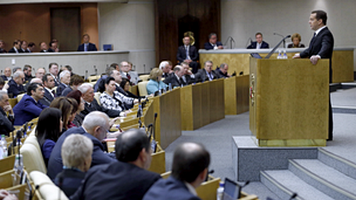The imputed tax system for LLCs and entrepreneurs provides for exemption from a number of deductions to the budget. In Art. 346.26, p. 4, TC lists cases when this mode is in effect. Next, we consider in more detail what constitutes an imputed tax system. 
General information
A simplified and imputed taxation system can be applied to entrepreneurs in cases established by the Tax Code. The payment of deductions under this scheme provides for exemption from income tax (in relation to income taxed by UTII), on property (in relation to the part that is used in business to generate income taxed by UTII). Also, the company does not pay the following taxes when imputed tax system:
- Social deductions (regarding payments made by individuals in connection with participation in commercial turnover taxed by UTII).
- VAT (relative to related transactions).
In the latter case, the exception will be VAT payable according to the Tax Code for the import of products into the customs territory of the Russian Federation.
Insurance premiums
The imputed tax system involves deductions to the Pension Fund in accordance with the procedure provided for in Federal Law No. 167. In addition, payers pay contributions for compulsory social insurance against occupational diseases and accidents. This provision is provided for in Federal Law No. 125. 
Tax Code: imputed tax system
In accordance with the legislation, entrepreneurs must comply with the rules of cash and settlement transactions in cashless and cash forms. According to Art. 346.26, paragraph 5, the use of CMC is prescribed. Object of taxation at UTII acts imputed income. It is presented as a potential profit. It is calculated in accordance with a set of conditions that directly affect the receipt of this income. The imputed tax system provides for a certain rate for determining the amount payable.
Payment
The amount of imputed income acts as a tax base for calculating the amount of UTII. It is calculated as the product of total profit - the conditional monthly yield in value terms defined for the period and the value of the physical indicator. The latter characterizes the type of activity of the enterprise. The resulting amount is adjusted by the corresponding coefficients by multiplying by them. These tariffs show the degree of influence of certain conditions on the result of commercial activities that are taxed with imputed tax. In particular, the coefficients are used:
1 TO 1. It is set for the calendar year. This deflator coefficient takes into account changes in the consumer value of products (services / works) in the previous period. 
2. K2. This is a corrective measure of basic return. It takes into account the complex features of doing business. Among them:
- range;
- seasonality;
- operating mode;
- amount of income;
- features of the place where work is carried out, and so on.
The quarter is the tax period. UTII rate - 15% of income. This size is set in Art. 346.31 Tax Code. The due date is set in Art. 346.32, paragraph 1. The deduction is made according to the results of the period up to the 25th day of the month that follows after its end.
Amount Adjustment
In Art. 346.32, paragraph 2, provides for a reduction in the amount of the single tax calculated for the period by:
- contributions paid for the same cycle on pension (compulsory) insurance of workers employed in the relevant industries;
- compensation for temporary disability paid by an employee from taxpayer funds.
Contributions for pension (compulsory) insurance may reduce the amount of UTII by no more than 50%. This requirement is contained in Art. 346.32, p. 2. 
Submission of a declaration
Reporting on the results of the period is submitted to the authorized bodies every quarter, no later than the 20th day of the month of the next cycle. The order of the Ministry of Finance approved the instructions for the preparation and form of the declaration. The document includes the following parts:
- Title page. It contains information about the entrepreneur and the body where the report is submitted, and other general information.
- Section 1. It indicates the amount of UTII payable by entrepreneurs who use the imputed tax system (the types of activities falling under UTII are listed in Chapter 26.3 of the Tax Code).
- Section 2. It calculates UTII for each specific type of activity and place of its implementation.
- Section 3. It reflects the amount for the period. In this section, the calculation of the quarterly amount of deductions, which provides imputed tax system for individual entrepreneurs, the activities of which fall under the UTII.
- Section 3.1. It reflects the amount of UTII, which is subject to deduction for the period in the budget. The calculation is performed using a specific OKATO code.

Simplified and imputed tax system
Many entrepreneurs and small businesses cannot use the simplified tax system, since they fall under the UTII. In 1998, as part of the tax reform, the Federal Law was approved, establishing a single tax, through which the state tried to simplify the reporting system for small enterprises and increase revenues from them. Subsequently, an entire chapter was created in the NK dedicated to UTII. The imputed system of taxation was to attract enterprises engaged in such areas where control is very difficult to pay the mandatory fees. Among them are retail trade, transport and consumer services, catering and other industries, in the framework of which settlements are carried out mainly in cash (cash).
Practical application of the regime
According to some experts, the introduction of a unified taxation system was a somewhat unsuccessful decision. Almost immediately after the appearance of the system was called "insane." This was due to a large number of various errors and discrepancies, as well as a fiscal orientation, expressed quite clearly. At the same time, it should be said that, in general, the idea of using a single tax on imputed income is very attractive and has been successfully applied in practice. A small enterprise makes deductions, calculated on the basis of objective indicators, for income that is established by law for it, and works quietly further, without worrying about obligations to the Federal Tax Service. In practical implementation within the framework of the domestic economy, UTII brought a lot of difficulties to the work of entrepreneurs. 
The main disadvantages of UTII
The transition to the imputed system is mandatory for enterprises that operate in industries that are quite popular in small business (trade, consumer services, and so on). The state, apparently, believes that the massive use of the simplified tax system will lead to a general evasion of mandatory payments to the budget. However, in practice, the UTII regime prevents the optimal operation of enterprises.
A number of experts analyzing the imputed system speak of its imperfection and subjectivity. Experts argue their position with the fact that in the calculations a small number of reducing (increasing) coefficients are applied, biased basic indicators of profitability. In addition, acceptable rates for calculating UTII in the Russian Federation cannot be due to a change in the economy and the lack of statistical information. Due to the imperfection of the calculation method, the tax amount is usually quite high.This, of course, increases the volume of obligations of the enterprise. From this, the reason for the lack of volunteers for the transition to UTII becomes clear. 
The opinion of entrepreneurs
Numerous reviews indicate that the introduction of an imputed tax system increased the burden on enterprises by at least 10 times. Another drawback is the unresolved issue regarding VAT. This problem has not been resolved even in the application of the simplified tax system. The regional nature of the imputed system led to the fact that the local government, noting during the first year rather good results in terms of the amount of funds received from enterprises in the budget, decided not to stop there. As a result, the base rate of return was changed upwards. This, in turn, has led to a new tightening of the burden of obligations.








